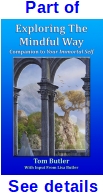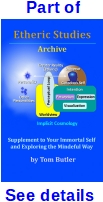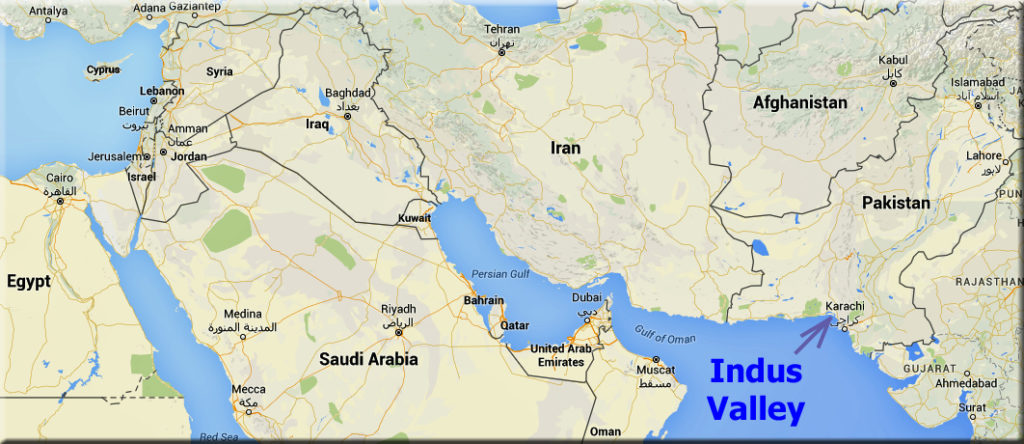Also see:
The Hermes Concepts
Metaphysical View of John 14
The Razor’s Edge – Katha Upanishad
The One Thing
Christmas is for Compassion
Introduction

 The Razor’s Edge refers to one of the ancient wisdoms concerned with the development of spiritual maturity. You may remember that there is a book titled The Razor’s Edge, and later, at least two movies based on the book.1 The story is about a person’s journey to India to seek the transcendent meaning of life.
The Razor’s Edge refers to one of the ancient wisdoms concerned with the development of spiritual maturity. You may remember that there is a book titled The Razor’s Edge, and later, at least two movies based on the book.1 The story is about a person’s journey to India to seek the transcendent meaning of life.
The phrase is found in the ancient Hindu Vedic Sanskrit text called the Katha Upanishad. The over 200 Upanishads describe the nature of ultimate reality and the path to gain spiritual maturity. They are thought to have been written 3,000-to-4,000 years ago and are based on oral tradition about truths given to seekers by the gods. There is also some evidence that Buddhism may have adopted concepts credited to the same origin.
Upanishad is from Sanskrit, probably originally as Upanishad. Katha can be understood as story or legend and Upanishad refers to sitting down near something, presumably a teacher. The Upanishad originated from oral tradition that likely predates the usual 1,800-2,000 BCE stated for the origin of the written form.
Origin of the Upanishads
Some historians speculate that the oral tradition may have originated in Egypt some 6,000 years ago, during the time of Hermes. It is thought that the metaphysical concepts were spread by ancient traders across the Middle East and into the Indus valley in what is Pakistan today.
Existence of essentially the same important concepts in many different cultures provides hints about how they may have evolved. If a particular concept such as mind-body duality was taught in ancient Egypt, then it is not particularly unexpected to see it also taught in Hinduism and Christianity.

Invocation
It is common, when seeking personal understanding with the help of our unseen friends, to speak a prayer designed to align teacher, student and helper’s intention.
According to Swami Krishnananda,4 every Upanishad lesson between a teacher and student begins and ends with an invocation of peace called the Shanti Mantra. As Swami Krishnananda’s invocation is translated:
May we both be protected.
May both of us be taken care of properly.
May we study together.
May our teaching and learning be resplendent.
May there be no misunderstanding between us.
May there be no discord of any kind.
May there be peace, may there be peace, may there be peace.
According to Swami Krishnananda, “It means that there should be proper attunement of spirit between the Guru and disciple before they begin the study, for only then will the teaching be fruitful.”
He also explains the three repetitions of “may there be peace,” as “We have three kinds of troubles called tapatraya (internally, physical ones), externally from outside beings and from above given by the gods.”
Katha Upanishad
The Katha Upanishad is told as a story about a boy, his father and the god of death. It is concerned with the nature of God as Source, individual seeking of greater understanding and the relationship between Self and the human body.
As with any text written in ancient times, Katha Upanishad has been translated by a number of modern scholars. This has resulted in many different versions. Because of this, it is necessary to focus on the underlying meaning, rather than taking them in a literal sense.
The Story
As I understand the translations, Katha Upanishad begins with Gautama’s sacrifice of all his worldly possessions to the gods, expecting good favor in return. Nachiketa notices that his father’s sacrifice is insincere because the possessions were only those which were worn out. He asked his father, “I too am yours, to which god will you offer me?”
Gautama’s terse response was, “I give you to Yama (the god of death).”
Nachiketa went to Yama’s home but Yama was away and Nachiketa had to wait. Yama returned after three days and expressed regret that Nachiketa had to wait so long. He told Nachiketa, “You have waited three days so ask three favors of me.”
Nachiketa asked for peace for his father and to learn the sacred fire sacrifice. Yama agreed.
For his third request, Nachiketa asked to learn the mystery of what comes after death. Yama pleaded with him to ask something else. Nachiketa insisted so Yama tested the boy by offering him wealth instead of the secret. The boy chose the path of spiritual understanding over the path of material possessions. This pleased Yama, and so he agreed to tell the boy about what came after death.
Yama explained that the key to understanding what comes after death is to understand that self, which is within each person, is inseparable from the Supreme Spirit, the vital force in the universe. In this regard, Part 1-II of Katha Upanishad is concerned with the need for a person to realize the importance of consciously deciding to seek understanding.
Brahman is a Sanskrit word for Supreme Spirit or creative principle present in everything.
The part of the story concerned with The Razor’s Edge is here and a brief discussion about the lesson is provided after. The material quoted here is from the Vedanta Spiritual Library:2
1-III-3. Know the Self to be the master of the chariot, and the body to be the chariot. Know the intellect to be the charioteer, and the mind to be the reins.
1-III-4. The senses they speak of as the horses; the objects within their view, the way. When the Self is yoked with the mind and the senses, the wise call It the enjoyer.
1-III-5. But whoso is devoid of discrimination and is possessed of a mind ever uncollected – his senses are uncontrollable like the vicious horses of a driver.
1-III-6. But whoso is discriminative and possessed of a mind ever collected – his senses are controllable like the good horses of a driver.
1-III-7. But whoso is devoid of a discriminating intellect, possessed of an unrestrained mind and is ever impure, does not attain that goal, but goes to samsara.
Samsara is Hindu for the cycle of death and rebirth as life is bound to the material world.
1-III-8. But whoso is possessed of a discriminating intellect and a restrained mind, and is ever pure, attains that goal from which he is not born again.
1-III-9. But the man who has a discriminating intellect as his driver, and a controlled-mind as the reins, reaches the end of the path – that supreme state of Vishnu.
Supreme state of Vishnu refers to self-realization or self-knowledge.
1-III-10. The sensory objects are subtler than the senses, and subtler than the sensory objects is mind. But intellect is subtler than mind and subtler than intellect is Mahat (the Hiranyagarbha).
Mahat refers to the origin or Source of creation. Hiranyagarbha can be understood as the golden egg, where gold means objects of fulfilment and joy.
1-III-11. The un-manifested (Avyakta) is subtler than Mahat (Hiranyagarbha) and subtler than the un-manifested is Purusha. There is nothing subtler than Purusha. That is the end, that is the supreme goal.
The universe itself is a person, though without the limitations and prejudices of our human personality. This is what the science of Yoga calls the Purusha. The Purusha, meaning a person or conscious being, is a Sanskrit term for the Cosmic Being behind the universe, the spirit within all things. The entire universe is a manifestation of the Cosmic Person. This Cosmic Person endows every creature with personhood or a sense of self, not only humans but also animals and ultimately all of nature.6
1-III-12. This Self hidden in all beings does not shine. But by seers of subtle and pointed intellect capable of perceiving subtle objects, It is seen.
1-III-13. Let the wise man merge speech in his mind, merge that (mind) into the intelligent self and the intelligent self into the Mahat. (Let him then) merge the Mahat into the peaceful Self.
1-III-14. Arise, awake, and learn by approaching the exalted ones, for that path is sharp as a razor’s edge, impassable, and hard to go by, say the wise.
1-III-15. By knowing that which is soundless, touchless, formless, un-decaying, so also tasteless, eternal, odourless, beginningless, endless, subtler than Mahat and constant, man is liberated from the jaws of death.
A Hindu Teacher’s Translation
According to Gupta,3 Yama’s explanation is a succinct description of Hindu metaphysics, and focuses on the following points:
- Yama said [in 1-II] there are the two life paths: pleasant/attractive and good/transcendental.
- Pleasant/attractive, which is the path of material pleasures that tempts humans, leads to death.
- Good/transcendental, which is the path of spiritual bliss, leads to immortality.
- By a process of detached thinking, the clear minded choose the path of immortality and the muddle headed fall for the path of pleasure and eventual pain and death.
- The sound Om! is the syllable of the Supreme Spirit
- The self is the same as the omnipresent Supreme Spirit. Smaller than the smallest and larger than the largest, the self is formless and all-pervading.
- The goal of the wise is to know this self.
- The self is like a rider; the horses are the senses, which self guides through the maze of desires.
- After death, it is the self that remains; the self is immortal.
- Mere reading of the scriptures or intellectual learning cannot lead to the realization of self.
- One must discriminate the self from the body, which is the seat of desire.
- Inability to realize Brahman results in one being enmeshed in the cycle of rebirths.
- Realization of the self leads to liberation from the cycle of life and death
Universal Message
Preparing this essay has been an adventure for me. What I refer to as the Trans-Survival Hypothesis and its Implicit Cosmology explain a model of reality which I believe represents current science and understanding gleaned from transcommunication.5 It is exciting to me that the Katha Upanishad very closely agrees with that cosmology.
While I had considered the Hermetic teaching and John 14 of the Bible, I had never looked at Hindu philosophy, mainly because of its convoluted terminology. After reading the Katha Upanishad, I took a close look at my prior understanding that religion was thought to have begun in the Hindus valley as it evolved from Arian philosophy. Now I see that the philosophy contained in the Upanishads probably originated millennia earlier in Egypt as the same source attributed to Hermes.
Here is a brief translation of the Katha Upanishad in terms of the Implicit Cosmology:
1-III-3 describes the avatar model used to describe the relationship between mind and body. In this model, mind is described in three parts: personality is the normally unconscious core intelligence which provides purpose; mind is the normally unconscious functional areas supporting perception and expression; and, Self is the conscious aspect of who we are.
In this model, the intellect is conscious self’s expression of intention which can be thought of as one of two steering influences on mostly unconscious mind. The second steering influence on mind is the urge or spiritual instinct to gain understanding expressed by personality. See the Prime Imperative Essay.
What the world looks like to self is managed in normally unconscious mind as Worldview, which is populated by cultural influences, prior understanding gain by the self/personality life field and human instincts. Worldview represents Self’s personal reality: Self’s perception of the world emerges into conscious awareness from the normally unconscious mind process which considers and translates environmental influences based on worldview.
1-III-5 and 1-III-6 refer to the conscious influence of discerning intention on normally unconscious mind. This is the foundation concept of the Mindful Way.
1-III-7 and 1-III-8 refer to the results of consciously applying accumulating understanding to discerning actions. This is another foundation concept in the Mindful Way.
1-III-9: “Supreme state of Vishnu” is a reference to self-realization or self-knowledge. This line tells us that mindfulness and conscious seeking may lead to the form of understanding we think of in contemporary terms as spiritual maturity.
1-III-10 and 1-III-11 describe the characteristics of Source. This is the all is one concept of a universal infinite intelligence, rather than a human-like god. Source manifests in the following ways:
-
- In the avatar model, which is also described by the chariot analogy of the Upanishad, that which is sensed is transformed into subtle information able to be processed by the even more subtle mind. I refer to this as the Two Mind Solution to the Survival Hypothesis.
- The personality/mind/self complex or life field is subtle and not seen with the physical senses.
- Personality, as the core intelligence of the life field, is that which is immortal, and which is subtler than mind. (Here I would argue that the life field integrates personality, mind and conscious self. In this way, personality is the source of purpose, conscious self is the experiencing aspect of personality and mind is judge as the functional aspect of experiencing.) Personality, as the core intelligence of the life field, is that which is immortal, and which is subtler than mind. (Here I would argue that the life field integrates personality, mind and conscious self. In this way, personality is the source of purpose, conscious self is the experiencing aspect of personality and mind is the functional aspect of experiencing.)
- Mahat refers to the origin or source of creation, which is even more subtle than its aspects represented by the life field.
- Source is seen as infinitely present (all is one; Mahat), infinite possibilities with the potential to manifest reality (Avyakta) and the intelligent core of reality (Purusha).
This is important: Compare the personality/mind/self complex of the avatar and the Purusha (intelligent core of reality), Mahat (infinitely present) and Avyakta (potential) of Source. I describe a life field in the Implicit Cosmology as the basic building block of reality. As such, there are life fields and the expressions of life fields.
Source’s life field represents the reality field and it is based on what Source understands of itself. Our life field is an aspect of Source. This means we are functionally inside Source’s life field, but our reality is defined by our worldview and that is our life field.
The description of Source and the description of Self as the charioteer, in the Katha Upanishad, describe the same functional areas. Let us say that a life field consists of the Purpose Functional Area (Purusha for Source and the intelligent core of Personality for our life field) the experiencer functional area (Mahat of Source and conscious self of our life field) and the perception/expression functional areas (Avyakta of Source and normally unconscious mind of our life field).
The reason this is important is that I arrived at this model based on current science and lessons from transcommunication. It agrees with the model offered in the Katha Upanishad and probably offered by Hermes 6,000 years ago.
1-III-12 and 1-III-13 advise that the Self is in all things. An important cosmological point is that Source is the reality field and the life field of a person is an instance of the Source life field. As such, all things are either an aspect of Source or an aspect’s expression. The intelligent core, the potential to create and the universal presence, is in each of us.
These lines tell us that those who have learned to sense the subtle characteristics of reality can sense the presence of self/Source in all things. We are advised to integrate this understanding into our worldview so as to align our perception and expression with the actual nature of Source.
1-III-14 and 1-III-15 Advise that we should find a teacher and consciously step onto the path toward greater understanding. The path is a narrow way in that it is far from the excesses seen on either extreme. It is also a difficult way because it is so easy for the seeker to turn toward misconception and illusion.
Finally, we are told that it is through correct understanding that we may step off of the wheel of reincarnation to move further toward universal understanding. (More likely, we will find ourselves with new and even more interesting challenges to understand.)
References
- Maugham, W. Somerset. The Razor’s Edge. Vintage. 2003 (first published in 1944). ISBN-13: 978-1400034208.
- Reference 2 was Panoli, Vidyavachaspati V. (Translator). “Katha Upanishad.” Vedanta Spiritual Library. shastras.com/upanishads-krishna-yajur-veda/katha-upanishad/
- Gupta, K. “Soul, The Eternal Being.” Spirituality and Us. 2014. spiritualityandus.org/2014/09/14/soul-the-eternal-being/.
- Swami Krishnananda. “Commentary on the Katha Upanishad.” The Divine Life Society Sivananda Ashram. Rishikesh, India. swami-krishnananda.org/kathopanishad.html.
- Butler, Tom. “The Implicit Cosmology.” Etheric Studies. 2014. ethericstudies.org/implicit-cosmology/.
- Frawley, David. “Yoga, the Purusha and the Cosmic Being.” from the book: Yoga and the Sacred Fire, on the American Institute of Vedic Studies website. 2012. vedanet.com/2012/06/13/the-purusha-principle-of-yoga/.
![]()
